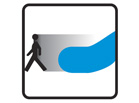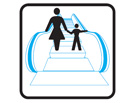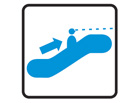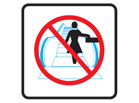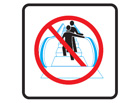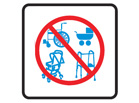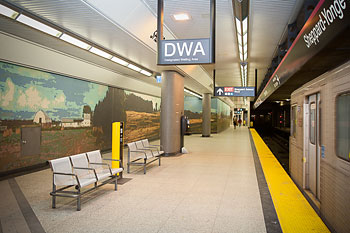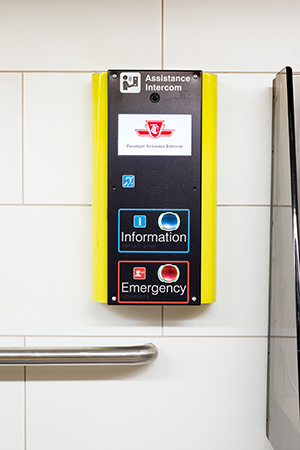Travelling safely
For emergencies on subway trains, please push the yellow strip. This is the quickest and most effective way to alert us in an emergency.
Subway customers can access 911 on any network in tunnels through the downtown U on Line 1, between Downsview and Vaughan Metropolitan Centre, and all open-cut areas. We are working on expanding this coverage to all tunneled sections of the subway system to ensure that help is always within reach.
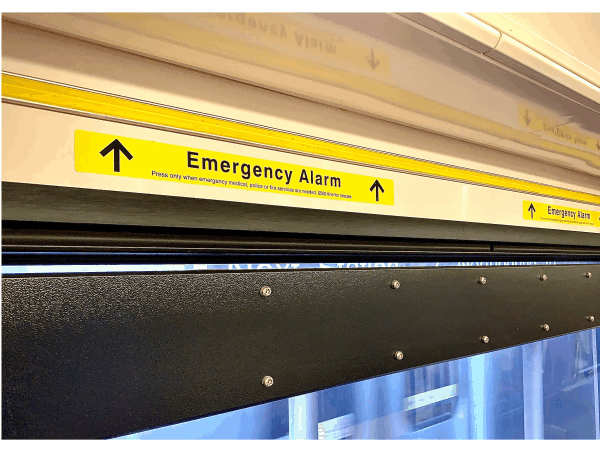
We’re committed to helping you travel the TTC network safely. Our Operators, Station Collectors, Customer Service Agents, TTC Special Constables and supervisory personnel are prepared to assist you. TTC personnel can easily be identified by their uniform and TTC crest.
Avoid slips, trips and falls
Bus and streetcar safety
- Never run for a bus or streetcar. You may slip and fall or be hit by a vehicle.
- Never run in front of a TTC vehicle to stop it. You may not be visible to the driver.
- Do not stick your arms or head out the window when riding a TTC vehicle.
- Once you are on a TTC vehicle stand behind the white line and stay clear of the doors.
- If you are standing on a TTC vehicle, hold onto the stanchions to avoid falling.
- At streetcar stops, wait for the streetcar to stop and open its doors, and then look left. When approaching traffic has stopped, step into the street and walk directly to the streetcar. When exiting, look right to ensure traffic has stopped and walk directly to the sidewalk.
- When boarding or leaving vehicles, keep all bags, parcels and backpacks clear of the doors. Carry these items in front of you.
- When travelling with children, be sure to assist them on and off our vehicles to ensure you do not become separated
What to do in an emergency on a bus or streetcar
- Bus and streetcar Operators have an alarm system and two-way radios to summon assistance.
- In an emergency, Operators can also turn on an audible alarm to attract the attention of police or passersby. An Operator can turn on flashing lights on the outside of the vehicle.
- If you see a TTC vehicle with an alarm ringing or its lights flashing, call 9-1-1 and report what you see.
Subway platform and train safety
- Stand back from the yellow platform edge strip until the train is stopped at the platform and the doors have opened.
- When entering or exiting the train, mind the gap between the train and the platform.
- When travelling with children, be sure to assist them on and off our vehicles to ensure you do not become separated.
- Listen for the door chimes and watch for the flashing orange light in the doorway. This is a warning that the doors are about to close. Do not try to board the train once the chimes have started ringing.
- Do not try to force open the car doors. You could get hurt and you could damage the door mechanism (which may prevent the train from proceeding).
- Never go down onto the tracks for any reason. If you drop something, leave it and tell a TTC uniformed employee.
What to do in an emergency at a subway station
- Tell the Station Collector immediately about any emergency. You can use the intercom in the Designated Waiting Area (DWA).
- Stop the escalator if someone falls or is caught. Push the red button at the top or bottom of the escalator.
- Turn off the track power if necessary. For example, if a person has fallen to the tracks or someone is caught in the door of a car and the train starts moving, you should cut the track power. Go to the nearest Emergency Power Cut Cabinet. There is one at each end of every subway platform; it is marked by a blue light. The instructions on the panel will show you how to cut the power to the tracks in both directions.
Escalator safety
- Step on and off carefully.
- Hold the handrail.
- Stand facing forward.
- Carry parcels. Do not rest them on the handrails.
- Keep clothing and shoes away from the sides. Ensure that laces on footwear are tied.
- Don’t rush other passengers.
- If travelling with a mobility device or a using a stroller, please use elevators.
- Do not let children use an escalator unattended.
Stair safety
- Walk, do not run.
- Hold the handrail.
- Keep to the right
- If travelling with a mobility device or using a stroller, please use elevators.
Your Safety Partner
Public telephones
Public Telephones are located on all subway station platforms, at station entrances and in many bus and streetcar transfer areas.
In an emergency, call 9-1-1. Calling 9-1-1 is always free. When police, fire, or medical emergencies occur, call 9-1-1. Trained emergency call takers will provide you with the information and assistance you need. Your exact location is on a sign near each telephone.
Security mirrors
Emergency alarm
If there is a situation that requires emergency medical, police or fire services, press the yellow emergency alarm strip. The emergency alarm is a yellow strip located above the windows, along the wheelchair positions and near the doors of the subway car.
When the emergency alarm is activated, the subway will proceed to the next station. The alarm alerts Transit Control, where specially trained staff triages the situation and contact 9-1-1, if required.
Whenever an emergency alarm is activated, service will be delayed anywhere from two to 20 minutes, depending on the nature or urgency of the incident. This is why it’s so important that the emergency alarm only be used for situations that require emergency medical, police or fire services.
There is a $500 fine for misuse of the emergency alarm.
Learn about when and how to use the emergency alarm on the subway by watching our video, TTC - In Case of Emergency ![]() .
.
Designated Waiting Areas (DWAs)
If you require assistance in a TTC station at any time or during an unplanned subway closure/emergency situation, please go to the Designated Waiting Area (DWA) and use the intercom on the platform or at any elevator to contact station staff. TTC station staff will contact emergency responders to provide assistance. When possible, you may also return to the train to the next accessible station and request assistance from staff. Transit Control will advise customers of significant delays and any accessibility impacts via service alerts.
Learn more about how to safely evacuate from a subway train or station on our Emergency Evacuation Procedures page.
Intercoms
Request Stop Program
- The request should be made at least one TTC stop ahead of the desired location.
- The Operator must be able to stop safely in order to meet your request.
- Exit the bus via the front doors, the rear doors will remain closed.
Reminder: Request Stop is not available on streetcars. Streetcars travel in the middle of the roadway too far from the sidewalk to let customers exit the vehicle safely at an unmarked stop.
Personal safety tips
Take care when walking to or from a TTC stop
- Walk with confidence. Do not become distracted. Avoid using your cell phone or other electronic devices. Keep your head up and be alert to your surroundings.
- Avoid taking short cuts or walking in unlit areas.
- Be aware of places where you can get help on your route, like open stores, restaurants and public telephones.
- If carrying a purse, knapsack or other bag, ensure it is zipped or fastened closed; hold it tightly and close to your body. Hold it in such a manner that any zippers or fasteners are visible to you at all times.
- If carrying a wallet, keep it in a front pocket.
- Keep the volume down on your music so you can hear the surrounding sounds.
Helpful tips when travelling with children or vulnerable persons
- Ensure there is adequate supervision/caregivers when travelling with groups, as required.
- Consider wearing uniform shirts or hats (high visibility) to easily identify group members.
- Plan your journey ahead of time. This should also include what to do in the event of an emergency, or if someone gets lost.
In the event of an emergency, please call 9-1-1 and report the matter to a TTC employee.
Auto theft
- Lock it and pocket the key - the majority of stolen cars are unlocked, often with the keys in the ignition. Always lock your car and take the keys with you. Do not leave your vehicle running.
- Keep your car keys and house keys on separate rings and never use an identification tag on your car key-ring.
- Do not hide an extra key on the outside of your car.
- Lock valuables out of sight in the trunk or glove compartment.
How to ruin a pickpocket’s day
- Do not become distracted. Avoid using your cell phone or other electronic devices. Keep your head up and be alert to your surroundings.
- Avoid crowding in areas around the doors of a vehicle.
- If carrying a purse, knapsack or other bag, ensure it is zipped or fastened closed; hold it tightly and close to your body. Hold it in such a manner that any zippers or fasteners are visible to you at all times.
- If wearing a backpack, carry it in front of your body.
- Carry wallets inside your coat or front pants pocket and never in a backpack.
- Avoid displaying valuables or large amounts of money in public. Use small bills when purchasing fare media.
- Carry only what you need. Avoid carrying unnecessary cash, credit cards and documents in your wallet or handbag.
- Beware of loud arguments or commotion. Incidents can be staged to distract while a pocket is being picked.
Report it
If you are the victim of a crime, it is important that you immediately report it to a TTC employee, TTC Special Constable or Toronto Police Officer. Provide detailed information about the incident such as suspect description, date, time, location and if possible TTC vehicle number.
If you see something suspicious report it to a uniformed TTC employee.

